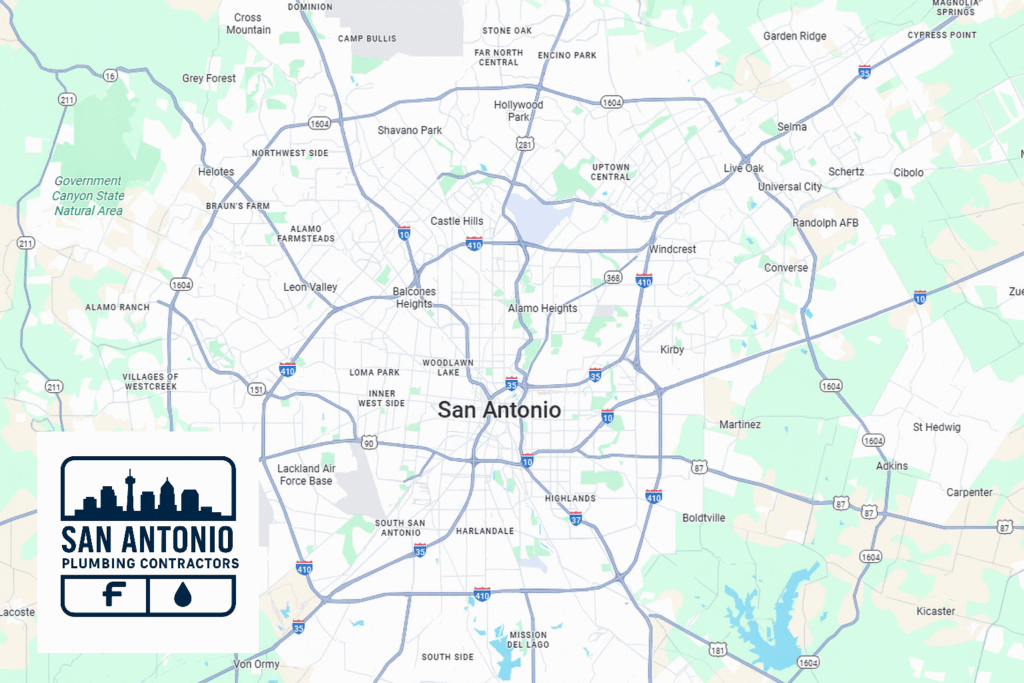

Hard Water & Scale Buildup in San Antonio — Causes, Problems & Fixes
Because groundwater in San Antonio travels through limestone, the city naturally has very hard water. Even though it’s safe to drink, the minerals often leave scale buildup that clogs fixtures and reduces water-heater efficiency. Consequently, appliances wear out sooner and water bills rise. Fortunately, the solutions are simple and readily available from local plumbing professionals.
Why the Water Here Is So Hard
First, the Edwards Aquifer dissolves calcium and magnesium from limestone. Next, those minerals remain in the water supply and appear as “hardness.” Finally, many areas measure about 15–20 grains per gallon, which classifies as very hard water.
- Safe to drink; however, minerals build up as scale.
- Visible impact: spots on glass, chalky fixtures, and sediment in heaters.
- Hidden impact: lower flow, noisy tanks, and higher energy use.
What “Scale” Actually Means
Scale is mostly calcium carbonate that forms whenever hard water is heated or evaporates. Consequently, it sticks to pipe walls, showerheads, and valves. Over time, pressure drops, efficiency declines, and maintenance needs increase.
Common Signs in San Antonio Homes
Homeowners typically notice several warning signs. For example, these issues often appear together after months without maintenance:
- White or chalky deposits on faucets and showerheads
- Soap scum on glass and tile
- Cloudy film on dishes or glassware
- Reduced water flow or clogged aerators
- Noisy water heater and limited hot water
- White sediment inside the heater tank
- Frequent appliance repairs or premature failure
- Higher energy bills from mineral buildup
- Shortened appliance lifespan overall
According to SAWS, white or light sediment is usually calcium carbonate; therefore, flushing your water heater yearly helps prevent buildup.
How Hard Is “Hard”? (Quick Reference)
| Category | Grains per Gallon | mg/L (ppm) |
|---|---|---|
| Soft | 0–3.5 | 0–60 |
| Moderate | 3.5–7 | 60–120 |
| Hard | 7–10.5 | 120–180 |
| Very Hard | >10.5 | >180 |
Because San Antonio typically measures 15–20 gpg, most homes benefit from installing a water softener or conditioner.
Prevention & Treatment Options
There are several approaches, and importantly, they work even better when combined with simple maintenance:
- Water softeners: Ion-exchange units offer the most consistent whole-home protection.
- Salt-free conditioners: These reduce mineral adhesion; however, they don’t remove the minerals themselves.
- Regular descaling: Flush the water heater annually and soak showerheads in vinegar. As a result, water pressure stays strong.
- Point-of-use filters: These filters improve taste and reduce spotting on dishes.
- Routine inspection: After installation, verify valves, pressure, and fixtures to maintain flow.
Hard Water FAQ
How hard is San Antonio’s water?
Most areas report around 15–20 gpg. Check the SAWS Water Quality Report, then set your softener accordingly.
Is hard water safe to drink?
Yes. The minerals are natural; however, they cause scale that reduces plumbing efficiency.
How can I remove existing scale?
First flush the water heater. Then soak faucets and aerators in vinegar. Finally, install a softener to prevent new deposits.
Do water softeners really save money?
Absolutely. By reducing mineral buildup, softeners help heaters run efficiently and appliances last longer. As a result, long-term costs drop.
Official Local Resources
For accurate numbers and water data, start with SAWS. In addition, you can review the local geology through Edwards Aquifer resources.
- SAWS: Water Quality FAQs
- SAWS: Troubleshooting Water Quality
- SAWS: Water Quality Report
- SAWS: Edwards Aquifer Source
Moreover, the SAWS Water Quality Report lets you confirm hardness by neighborhood and adjust your softener correctly.